HYUNDAI ELANTRA SEL 2021 User Guide
Manufacturer: HYUNDAI, Model Year: 2021, Model line: ELANTRA SEL, Model: HYUNDAI ELANTRA SEL 2021Pages: 570, PDF Size: 52.21 MB
Page 11 of 570
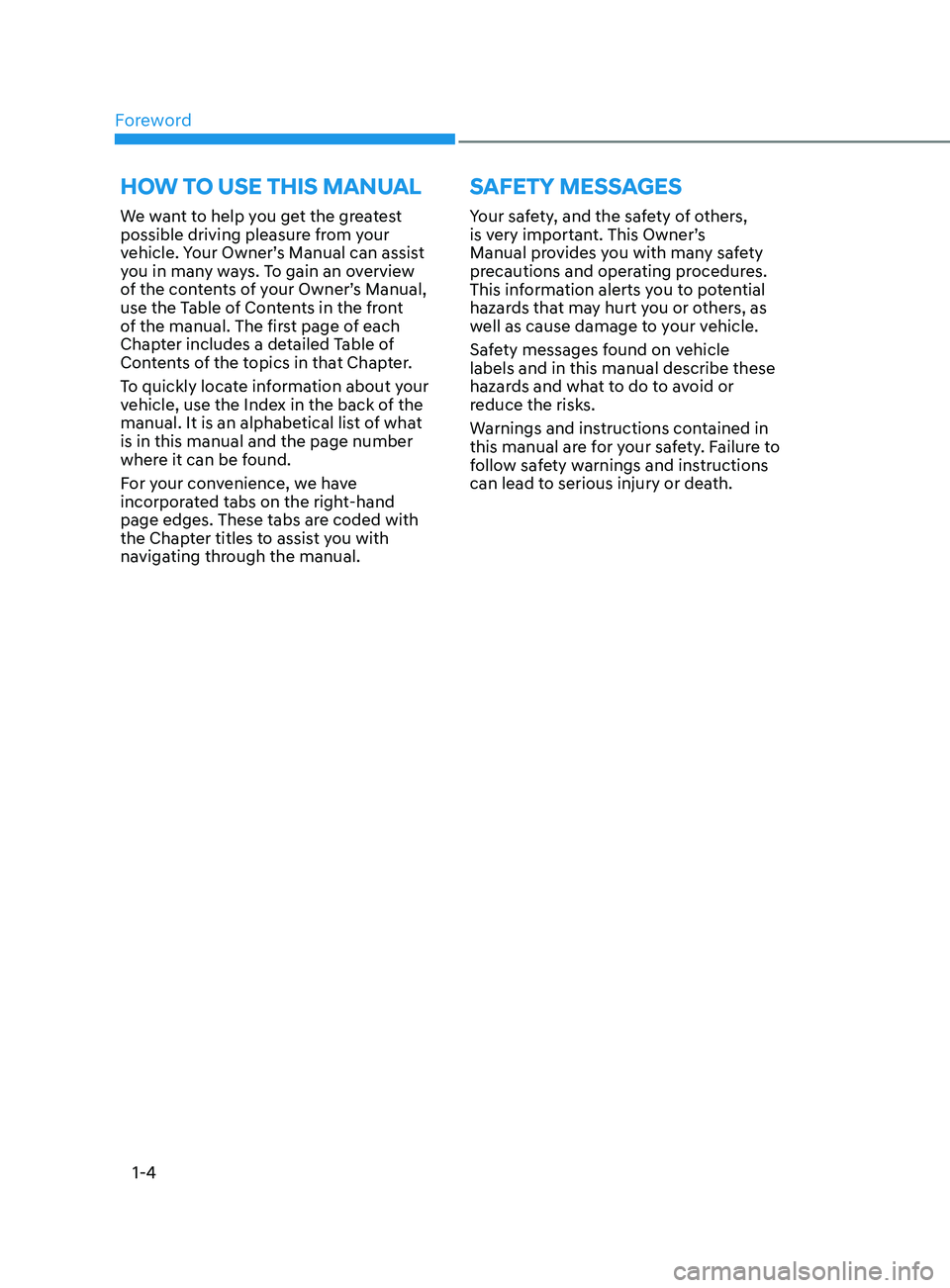
Foreword
1-4
We want to help you get the greatest
possible driving pleasure from your
vehicle. Your Owner’s Manual can assist
you in many ways. To gain an overview
of the contents of your Owner’s Manual,
use the Table of Contents in the front
of the manual. The first page of each
Chapter includes a detailed Table of
Contents of the topics in that Chapter.
To quickly locate information about your
vehicle, use the Index in the back of the
manual. It is an alphabetical list of what
is in this manual and the page number
where it can be found.
For your convenience, we have
incorporated tabs on the right-hand
page edges. These tabs are coded with
the Chapter titles to assist you with
navigating through the manual.Your safety, and the safety of others,
is very important. This Owner’s
Manual provides you with many safety
precautions and operating procedures.
This information alerts you to potential
hazards that may hurt you or others, as
well as cause damage to your vehicle.
Safety messages found on vehicle
labels and in this manual describe these
hazards and what to do to avoid or
reduce the risks.
Warnings and instructions contained in
this manual are for your safety. Failure to
follow safety warnings and instructions
can lead to serious injury or death.
How to use tHIs Manualsafety MessaGes
Page 12 of 570
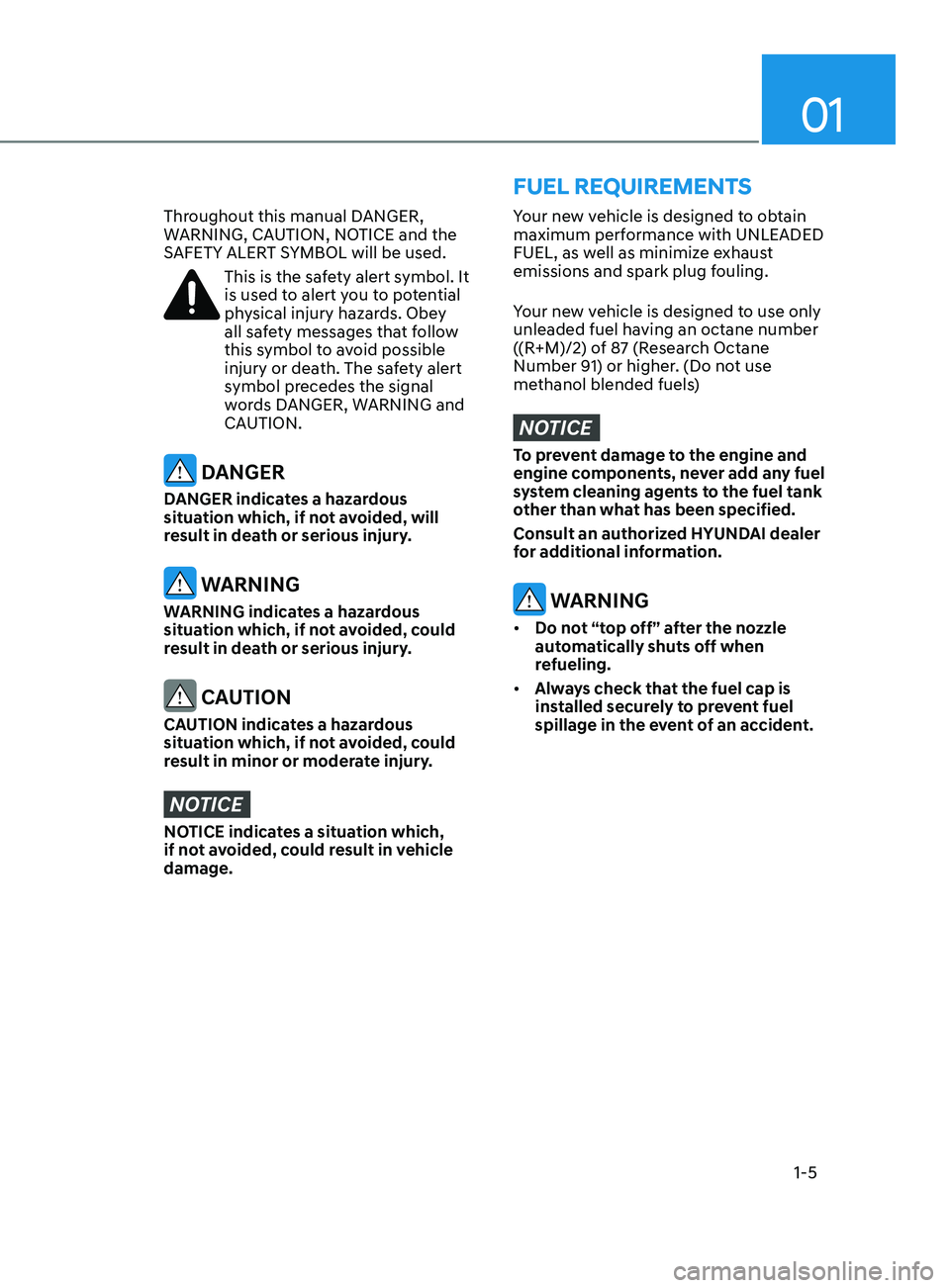
01
1-5
Your new vehicle is designed to obtain
maximum performance with UNLEADED
FUEL, as well as minimize exhaust
emissions and spark plug fouling.
Your new vehicle is designed to use only
unleaded fuel having an octane number
((R+M)/2) of 87 (Research Octane
Number 91) or higher. (Do not use
methanol blended fuels)
NOTICE
To prevent damage to the engine and
engine components, never add any fuel
system cleaning agents to the fuel tank
other than what has been specified.
Consult an authorized HYUNDAI dealer
for additional information.
WARNING
•Do not “top off” after the nozzle
automatically shuts off when
refueling.
• Always check that the fuel cap is
installed securely to prevent fuel
spillage in the event of an accident.
fuel requIreMents
Throughout this manual DANGER,
WARNING, CAUTION, NOTICE and the
SAFETY ALERT SYMBOL will be used.
This is the safety alert symbol. It
is used to alert you to potential
physical injury hazards. Obey
all safety messages that follow
this symbol to avoid possible
injury or death. The safety alert
symbol precedes the signal
words DANGER, WARNING and
CAUTION.
DANGER
DANGER indicates a hazardous
situation which, if not avoided, will
result in death or serious injury.
WARNING
WARNING indicates a hazardous
situation which, if not avoided, could
result in death or serious injury.
CAUTION
CAUTION indicates a hazardous
situation which, if not avoided, could
result in minor or moderate injury.
NOTICE
NOTICE indicates a situation which,
if not avoided, could result in vehicle
damage.
Page 13 of 570
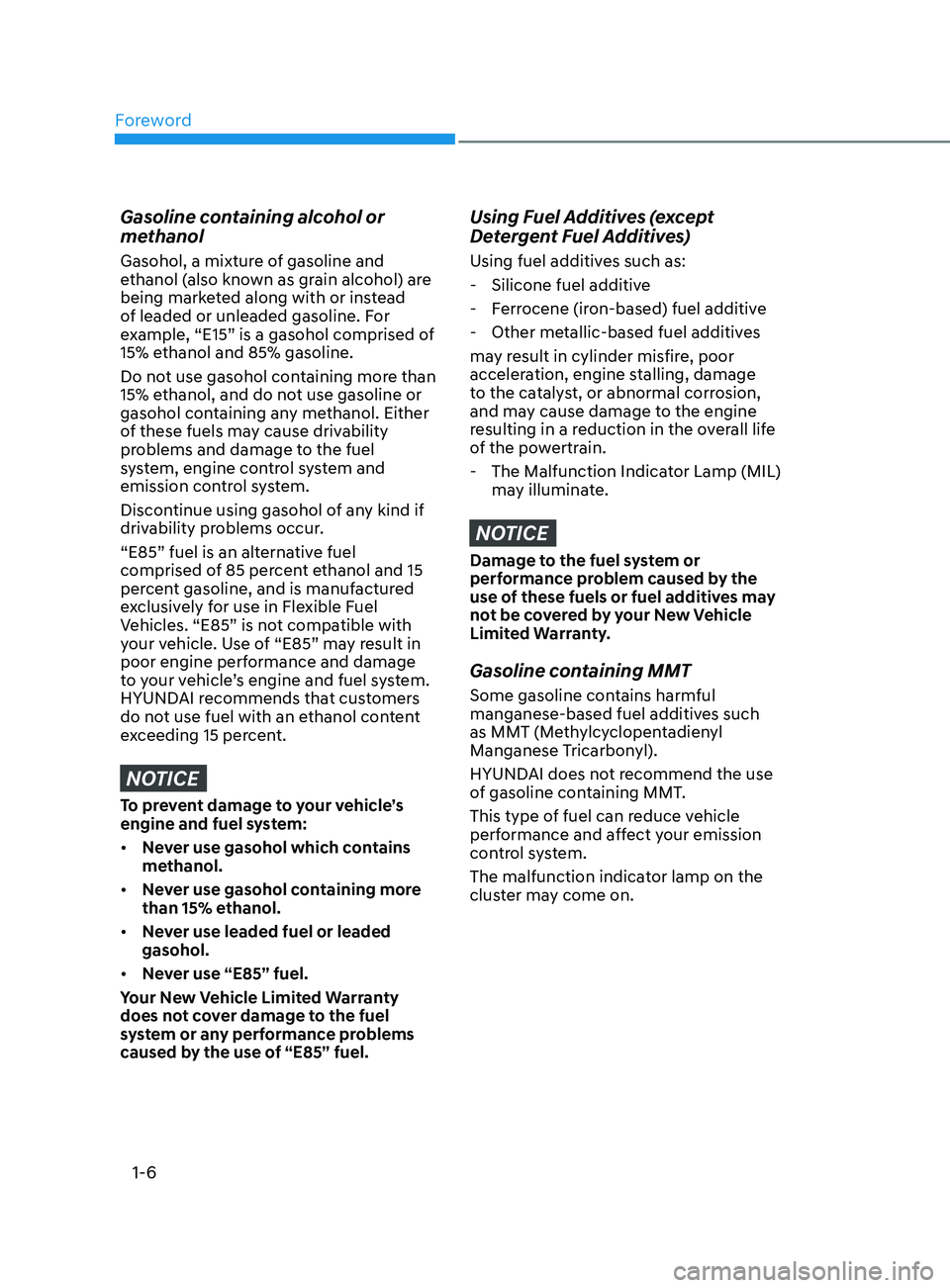
Foreword
1-6
Gasoline containing alcohol or
methanol
Gasohol, a mixture of gasoline and
ethanol (also known as grain alcohol) are
being marketed along with or instead
of leaded or unleaded gasoline. For
example, “E15” is a gasohol comprised of
15% ethanol and 85% gasoline.
Do not use gasohol containing more than
15% ethanol, and do not use gasoline or
gasohol containing any methanol. Either
of these fuels may cause drivability
problems and damage to the fuel
system, engine control system and
emission control system.
Discontinue using gasohol of any kind if
drivability problems occur.
“E85” fuel is an alternative fuel
comprised of 85 percent ethanol and 15
percent gasoline, and is manufactured
exclusively for use in Flexible Fuel
Vehicles. “E85” is not compatible with
your vehicle. Use of “E85” may result in
poor engine performance and damage
to your vehicle’s engine and fuel system.
HYUNDAI recommends that customers
do not use fuel with an ethanol content
exceeding 15 percent.
NOTICE
To prevent damage to your vehicle’s
engine and fuel system:
• Never use gasohol which contains
methanol.
• Never use gasohol containing more
than 15% ethanol.
• Never use leaded fuel or leaded
gasohol.
• Never use “E85” fuel.
Your New Vehicle Limited Warranty
does not cover damage to the fuel
system or any performance problems
caused by the use of “E85” fuel.
Using Fuel Additives (except
Detergent Fuel Additives)
Using fuel additives such as:
- Silicone fuel additive
- Ferr
ocene (iron-based) fuel additive
- Other metallic
-based fuel additives
may result in cylinder misfire, poor
acceleration, engine stalling, damage
to the catalyst, or abnormal corrosion,
and may cause damage to the engine
resulting in a reduction in the overall life
of the powertrain.
- The Malfunction Indicat
or Lamp (MIL)
may illuminate.
NOTICE
Damage to the fuel system or
performance problem caused by the
use of these fuels or fuel additives may
not be covered by your New Vehicle
Limited Warranty.
Gasoline containing MMT
Some gasoline contains harmful
manganese-based fuel additives such
as MMT (Methylcyclopentadienyl
Manganese Tricarbonyl).
HYUNDAI does not recommend the use
of gasoline containing MMT.
This type of fuel can reduce vehicle
performance and affect your emission
control system.
The malfunction indicator lamp on the
cluster may come on.
Page 14 of 570
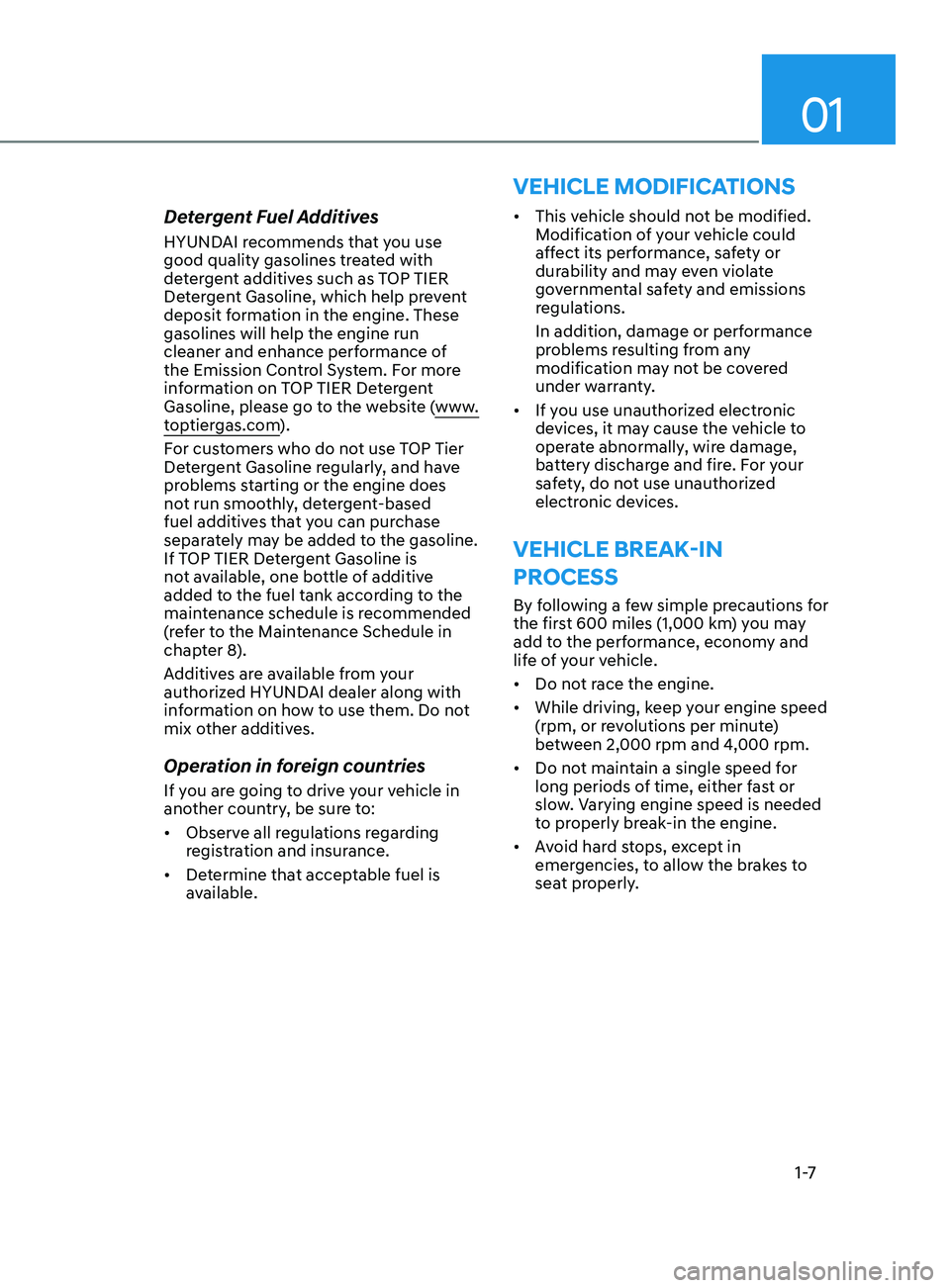
01
1 -7
Detergent Fuel Additives
HYUNDAI recommends that you use
good quality gasolines treated with
detergent additives such as TOP TIER
Detergent Gasoline, which help prevent
deposit formation in the engine. These
gasolines will help the engine run
cleaner and enhance performance of
the Emission Control System. For more
information on TOP TIER Detergent
Gasoline, please go to the website (www.
toptiergas.com).
For customers who do not use TOP Tier
Detergent Gasoline regularly, and have
problems starting or the engine does
not run smoothly, detergent-based
fuel additives that you can purchase
separately may be added to the gasoline.
If TOP TIER Detergent Gasoline is
not available, one bottle of additive
added to the fuel tank according to the
maintenance schedule is recommended
(refer to the Maintenance Schedule in
chapter 8).
Additives are available from your
authorized HYUNDAI dealer along with
information on how to use them. Do not
mix other additives.
Operation in foreign countries
If you are going to drive your vehicle in
another country, be sure to:
• Observe all regulations regarding
registration and insurance.
• Determine that acceptable fuel is
available. •
This vehicle should not be modified.
Modification of your vehicle could
affect its performance, safety or
durability and may even violate
governmental safety and emissions
regulations.
In addition, damage or performance
problems resulting from any
modification may not be covered
under warranty.
• If you use unauthorized electronic
devices, it may cause the vehicle to
operate abnormally, wire damage,
battery discharge and fire. For your
safety, do not use unauthorized
electronic devices.
Vehicle Break-in
Process
By following a few simple precautions for
the first 600 miles (1,000 km) you may
add to the performance, economy and
life of your vehicle.
• Do not race the engine.
• While driving, keep your engine speed
(rpm, or revolutions per minute)
between 2,000 rpm and 4,000 rpm.
• Do not maintain a single speed for
long periods of time, either fast or
slow. Varying engine speed is needed
to properly break-in the engine.
• Avoid hard stops, except in
emergencies, to allow the brakes to
seat properly.
VeHIcle ModIfIcatIons
Page 15 of 570
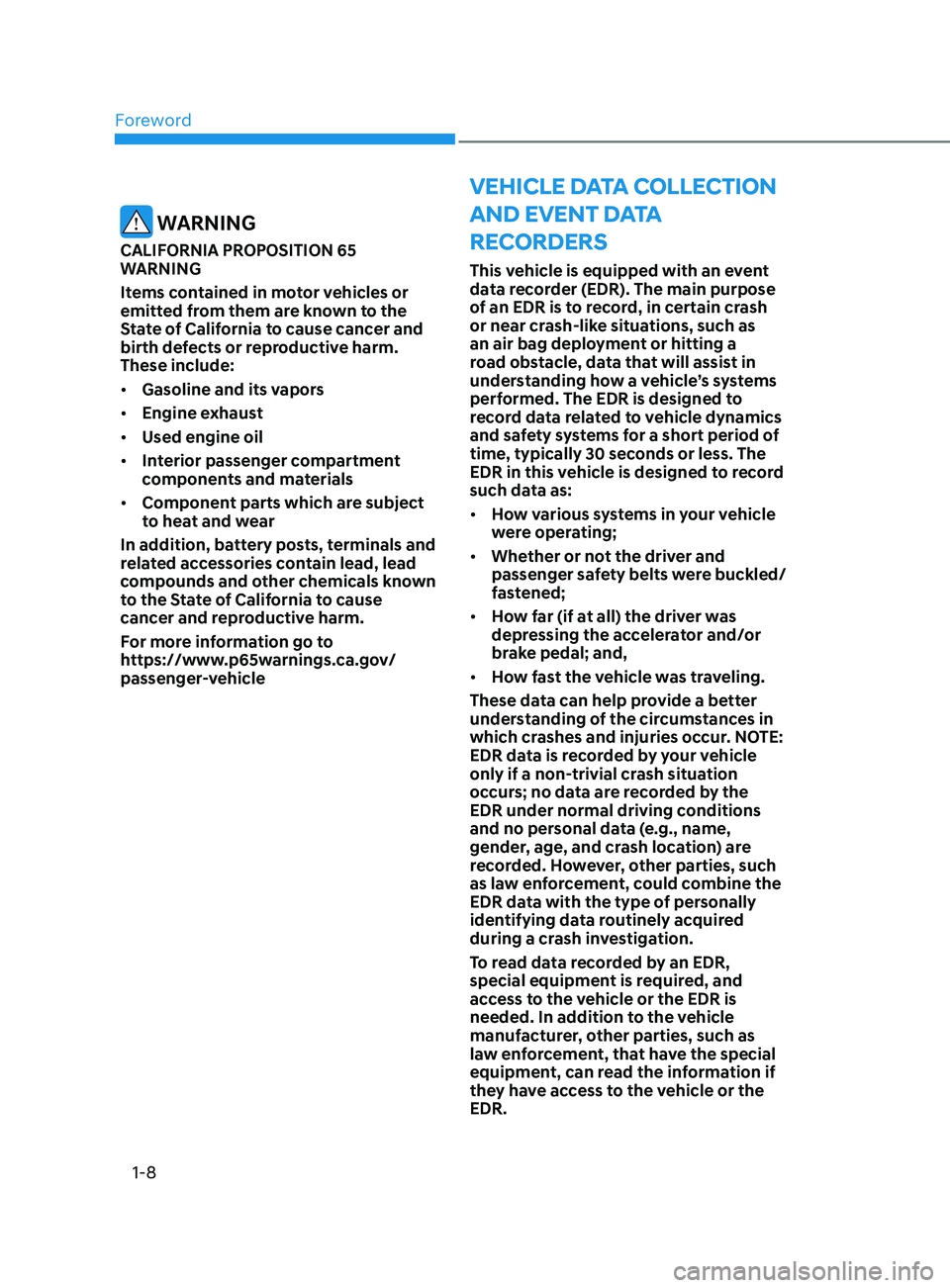
Foreword
1-8
VeHIcle data collectIon
and
eVent dat
a
re
corders
This vehicle is equipped with an event
data recorder (EDR). The main purpose
of an EDR is to record, in certain crash
or near crash-like situations, such as
an air bag deployment or hitting a
road obstacle, data that will assist in
understanding how a vehicle’s systems
performed. The EDR is designed to
record data related to vehicle dynamics
and safety systems for a short period of
time, typically 30 seconds or less. The
EDR in this vehicle is designed to record
such data as:
• How various systems in your vehicle
were operating;
• Whether or not the driver and
passenger safety belts were buckled/
fastened;
• How far (if at all) the driver was
depressing the accelerator and/or
brake pedal; and,
• How fast the vehicle was traveling.
These data can help provide a better
understanding of the circumstances in
which crashes and injuries occur. NOTE:
EDR data is recorded by your vehicle
only if a non-trivial crash situation
occurs; no data are recorded by the
EDR under normal driving conditions
and no personal data (e.g., name,
gender, age, and crash location) are
recorded. However, other parties, such
as law enforcement, could combine the
EDR data with the type of personally
identifying data routinely acquired
during a crash investigation.
To read data recorded by an EDR,
special equipment is required, and
access to the vehicle or the EDR is
needed. In addition to the vehicle
manufacturer, other parties, such as
law enforcement, that have the special
equipment, can read the information if
they have access to the vehicle or the
EDR.
WARNING
CALIFORNIA PROPOSITION 65
WARNING
Items contained in motor vehicles or
emitted from them are known to the
State of California to cause cancer and
birth defects or reproductive harm.
These include:
• Gasoline and its vapors
• Engine exhaust
• Used engine oil
• Interior passenger compartment
components and materials
• Component parts which are subject
to heat and wear
In addition, battery posts, terminals and
related accessories contain lead, lead
compounds and other chemicals known
to the State of California to cause
cancer and reproductive harm.
For more information go to
https://www.p65warnings.ca.gov/
passenger-vehicle
Page 16 of 570
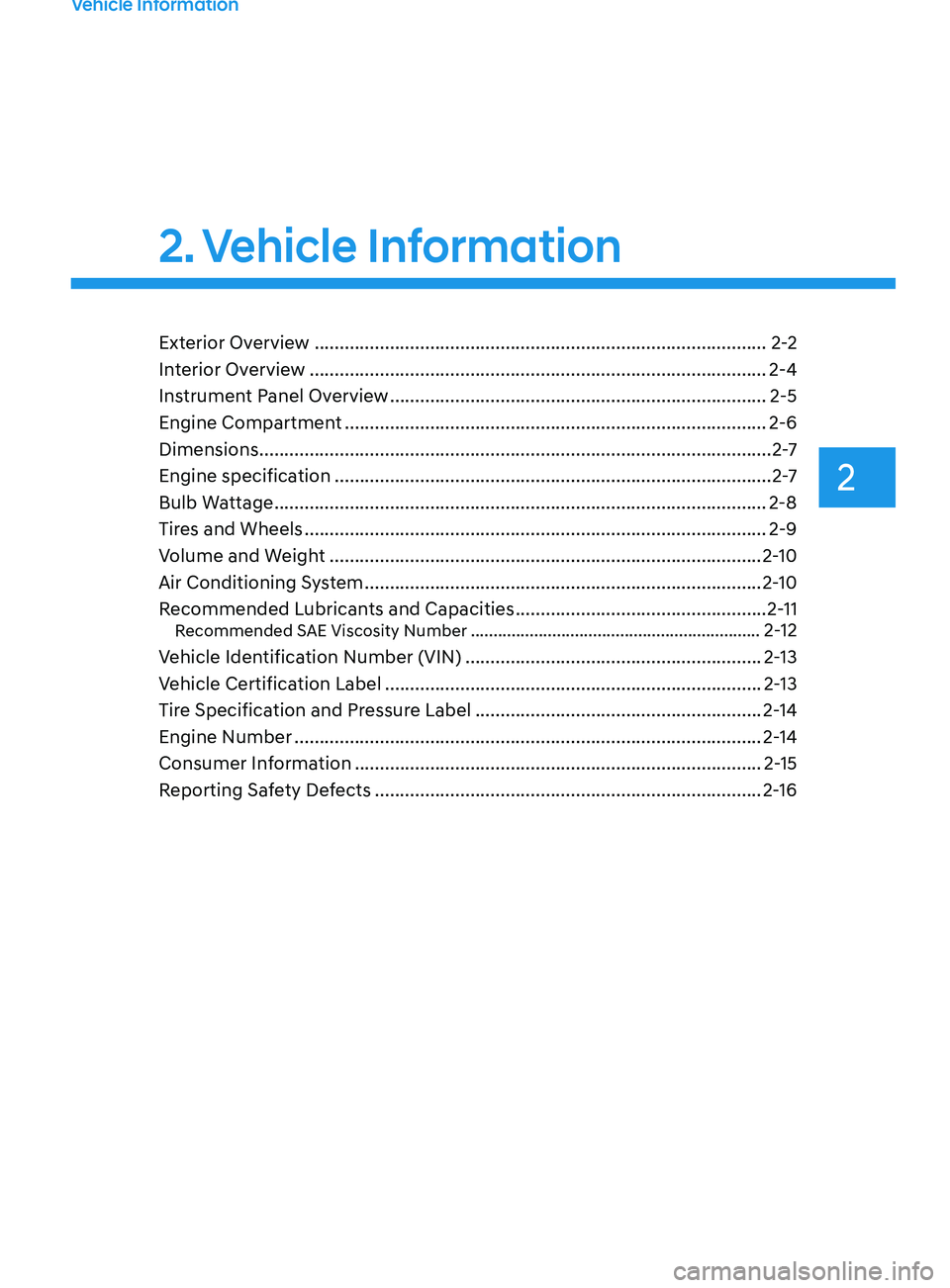
2
2. Vehicle Information
Vehicle Information
Exterior Overview ........................................................................\
..................2-2
In terior Overview
........................................................................\
................... 2-
4
Instrument Panel Overview
........................................................................\
... 2-
5
Engine Compartment
........................................................................\
............ 2-
6
Dimensions
........................................................................\
.............................. 2
-7
Engine specification
........................................................................\
............... 2
-7
Bulb Wattage
........................................................................\
.......................... 2-
8
Tires and Wheels
........................................................................\
.................... 2-
9
Volume and Weight
........................................................................\
.............. 2
-10
Air Conditioning System
........................................................................\
....... 2
-10
Recommended Lubricants and Capacities
.................................................. 2
-11
Recommended SAE Viscosity Number ................................................................2-12
Vehicle Identification Number (
VIN) ........................................................... 2
-13
Vehicle Certification Label
........................................................................\
... 2
-13
Tire Specification and Pressure Label
......................................................... 2
-14
Engine Number
........................................................................\
..................... 2
-14
Consumer Information
........................................................................\
......... 2
-15
Reporting Safety Defects
........................................................................\
..... 2-1
6
Page 17 of 570
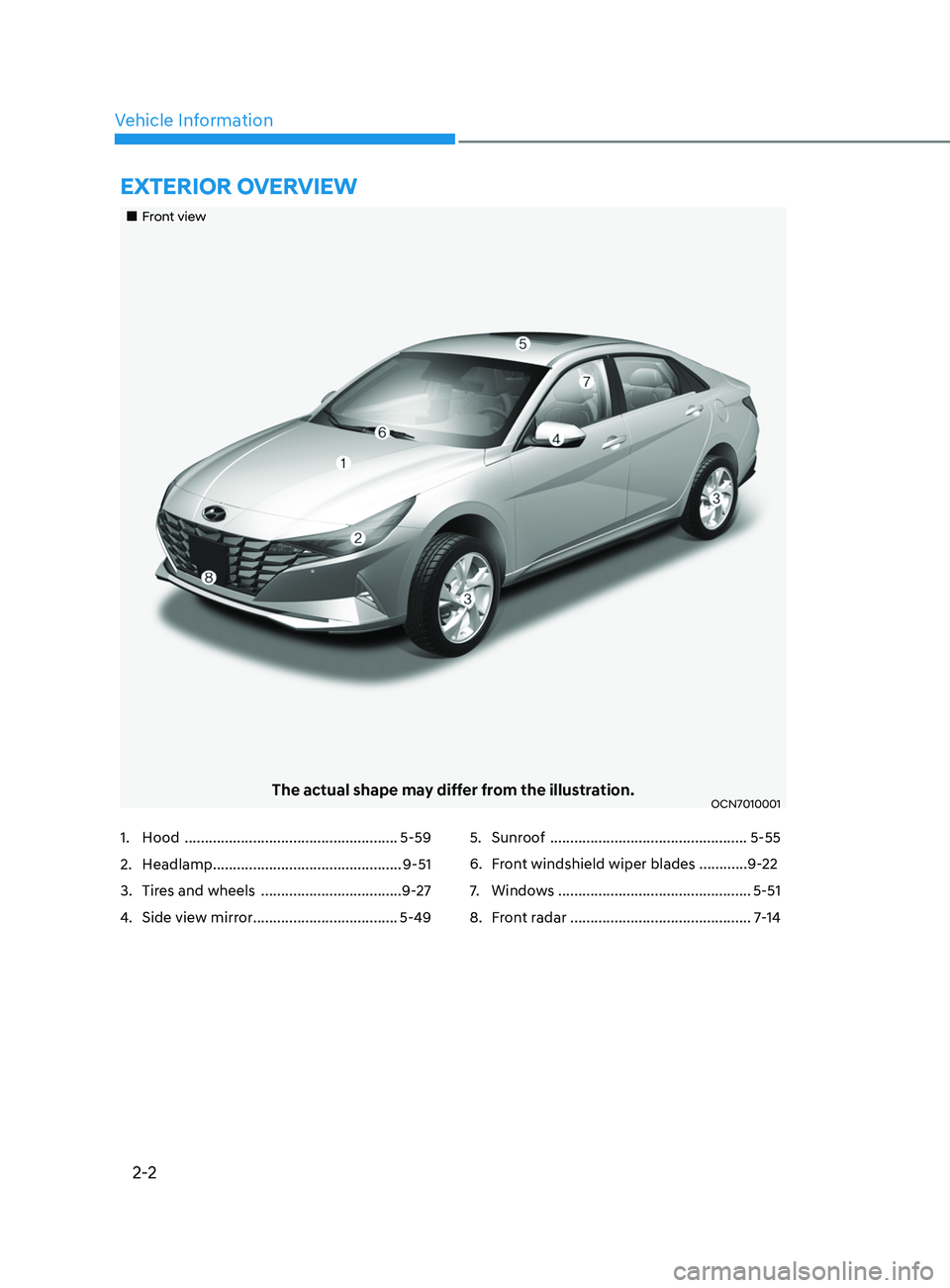
2-2
Vehicle Information
ExtErior ovErviEw
„„Front view
The actual shape may differ from the illustration.OCN7010001
1. Hood ..................................................... 5-59
2.
Headlamp ............................................... 9-51
3.
Tires and wheels ................................... 9-
27
4.
Side view mirr
or
.................................... 5-495.
Sunroo
f .................................................
5-55
6.
Fr
ont windshield wiper blades ............9-22
7.
Window
s
................................................5-51
8.
Fr
ont radar
.............................................7
-14
Page 18 of 570
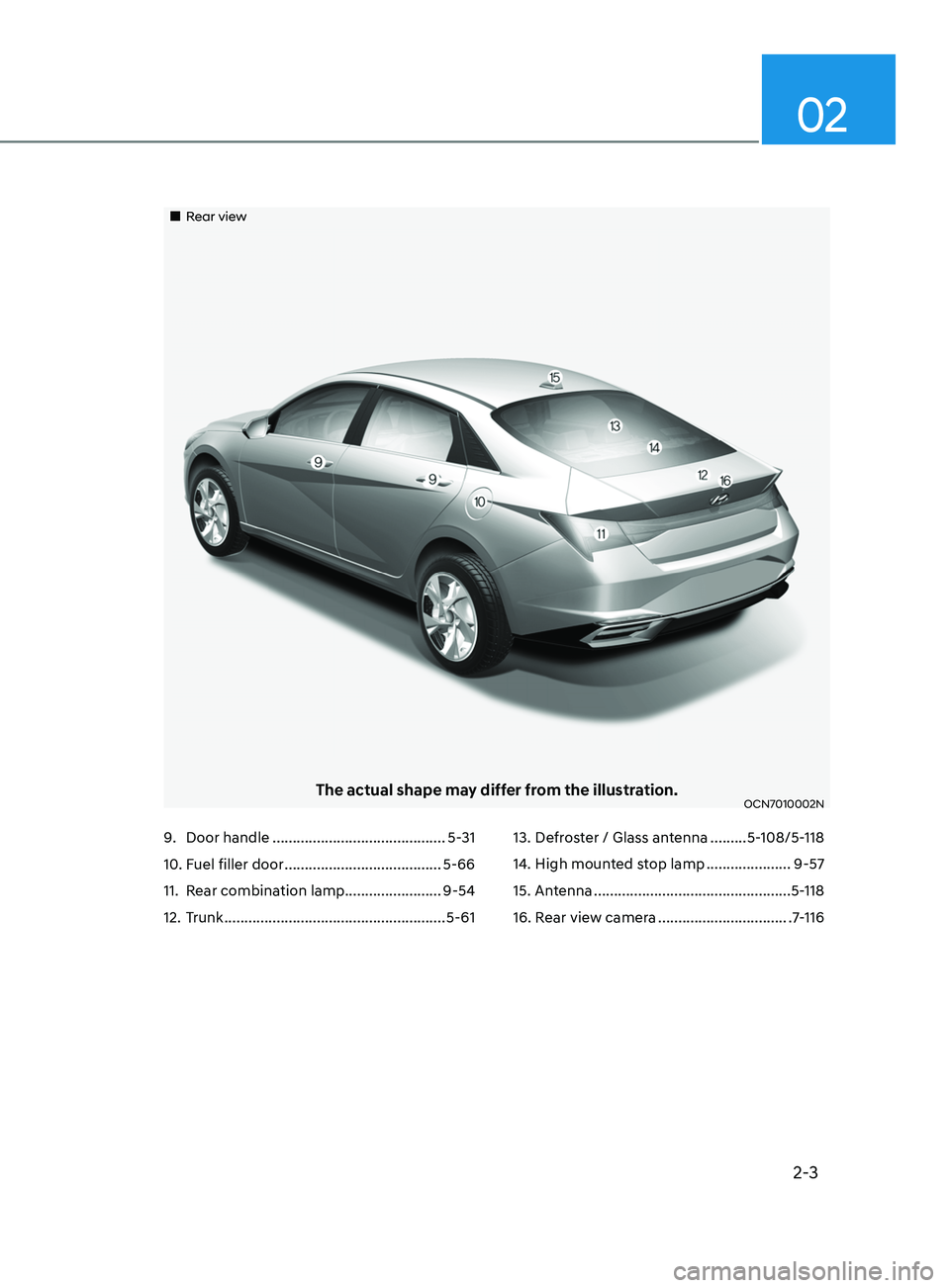
2-3
02
„„Rear view
The actual shape may differ from the illustration.OCN7010002N
9.Door handle ...........................................5-31
10 .
Fuel filler door ....................................... 5-66
11.
Rear combination lamp
........................ 9-54
12.
Trunk ....................................................... 5-6113.
Defros
ter / Glass antenna .........
5-108/5- 118
14.
High mounted s
top lamp
.....................9-57
15.
Antenna ................................................. 5-118
16.
Rear view camer
a
.................................7
-116
Page 19 of 570
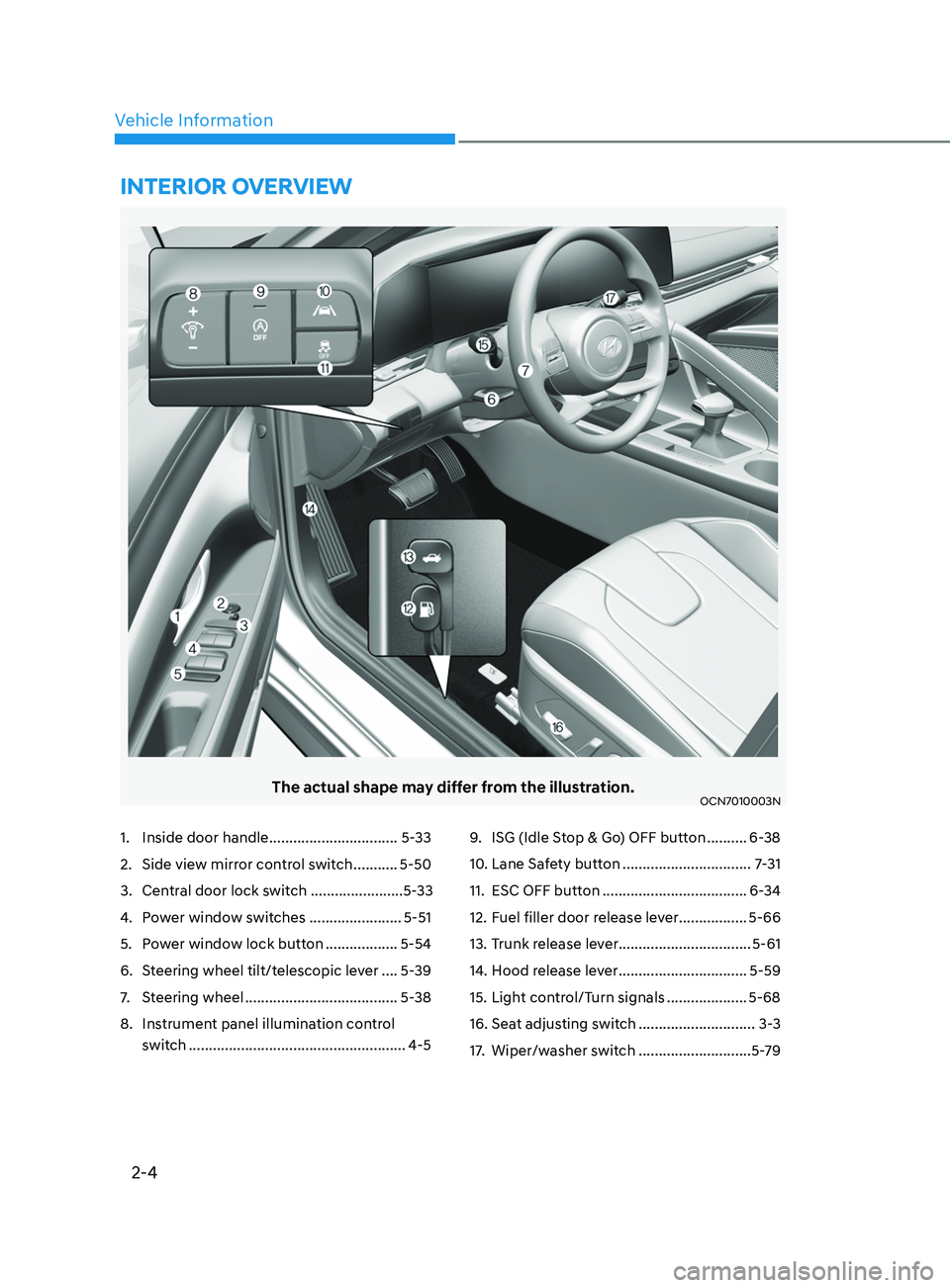
2-4
Vehicle Information
The actual shape may differ from the illustration.OCN7010003N
1.Inside door handle ................................ 5-33
2.
Side view mirror con
trol switch
...........5-50
3.
Central door lock s
witch .......................5-33
4.
Pow
er window switches
....................... 5-51
5.
Pow
er window lock button
.................. 5-54
6.
Steering wheel tilt/t
elescopic lever
....5-39
7.
Steering wheel ...................................... 5-38
8.
Instrument panel illumina
tion control
switch
...................................................... 4-59.
ISG (Idle St
op & Go) OFF button ..........
6-38
10 .
Lane Safe
ty button
................................7-3
1
11.
ESC OFF button .................................... 6-34
12.
Fuel filler door release le
ver
.................5-66
13.
Trunk release le
ver
.................................5-61
14.
Hood release le
ver
................................5-59
15.
Light contr
ol/Turn signals
....................5-68
16.
Seat adjusting s
witch
.............................3-3
17
.
Wiper/washer swit
ch
............................5-79
intErior ovErviEw
Page 20 of 570
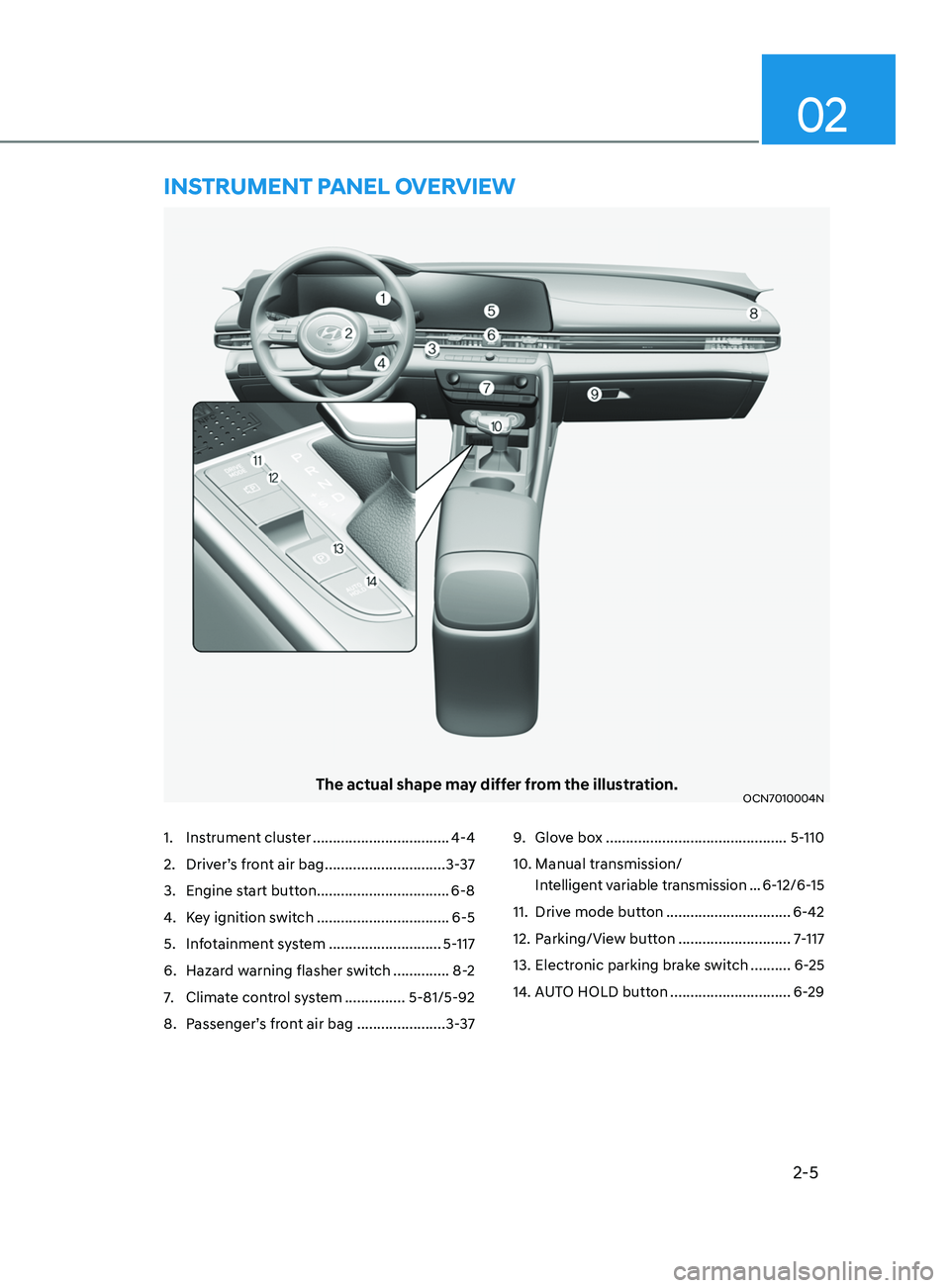
2-5
02
The actual shape may differ from the illustration.OCN7010004N
instrumEnt PanEl ovErviEw
1.Instrument cluster ..................................4-4
2.
Driver’s fr
ont air bag
.............................. 3-37
3.
Engine start butt
on................................. 6-8
4.
Key ignition s
witch
................................. 6-5
5.
Info
tainment system
............................ 5-117
6.
Hazard warning flasher s
witch
..............8-2
7.
Climate con
trol system
...............5-81/5-92
8.
Passenger’s fr
ont air bag
......................3-
379.Glove bo
x .............................................
5-110
10 .
Manual transmission/
Int
elligent variable transmission
...6-12/6-
15
11.
Drive mode button ............................... 6-42
12.
Parking/View butt
on
............................7-
117
13.
Electronic parking brak
e switch
..........6-25
14
.
AUTO HOLD butt
on
..............................6-29